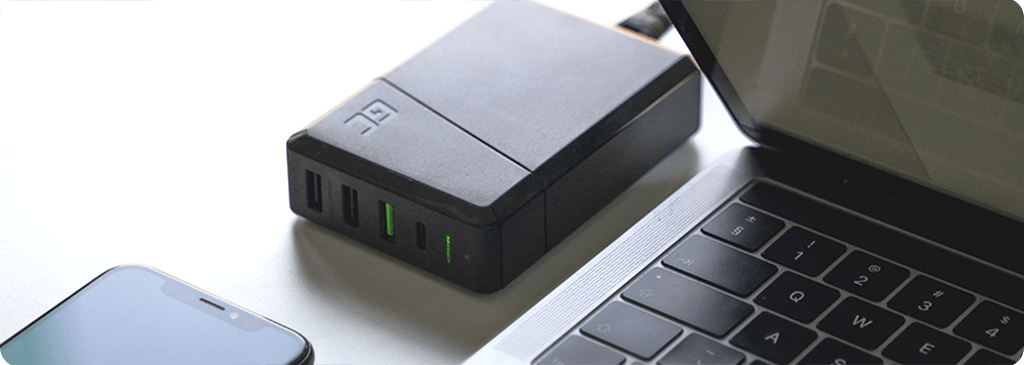Each of us wants our devices to be recharged as soon as possible and the power process to be as smooth and convenient for us as possible. At the moment we are observing a very interesting moment, when practically all our smartphones have two types of charging – wired and inductive. Each of these solutions has its pros and cons, which we will present in this text. Who will be better in a technology duel?
How does an inductive charger work?
Let’s start with wireless charging based on the electromagnetic induction phenomenon. The origins of this technology date back to 2009, when an international technology consortium (WPC), bringing together leaders in the mobile devices market, developed a standard specification known as Qi. In the case of wireless power, it is enough to put the phone on a charger to start charging. This gives you more freedom to use your phone. The strategically placed platform ensures that the phone is always within easy reach and you don’t have to attach yourself to a cable every time you want to test something.
Wireless chargers
Of course, induction chargers can also be found in our offer.Green Cell has prepared a 10W model that looks great on your desk and fits all Qi induction charging devices including Apple iPhone X, iPhone 8/8 Plus, Samsung Galaxy S8, Note 7. Rubber finishes prevent the whole thing from slipping and protect the phone from falling. A novelty is expected to come soon – a model called AirJuice with 15W of power.

Cable chargers
Let’s move on to the second way of power supply, wired charging. It allows to power practically any equipment – we do not have to check if our device is equipped with Qi standard. There are many technologies on the market that enable quick charging – Ultra Charge, Quick Charge or Power Delivery. Thanks to this, you can power your equipment with optimal speed, which often exceeds the capabilities of wireless. The best example of network chargers is Green Cell Power Source with 4 ports with USB-C PD compatible with ultrabooks and Ultra Charge technology. A total power of 75 watts is a modern approach to powering mobile devices. It will replace several traditional chargers with one. Power Source has a USB-C port with Power Delivery of up to 60 watts for all Ultrabooks and tablets equipped with this technology. Compatible with MacBook Pro 13 / 15, Dell XPS 13 / 15, Huawei MateBook X Pro, iPad Pro 11″ / 12.9″, among others. The USB-A Ultra Charge port will provide up to 3.5x faster charging for the latest iPhone 11 / XS / X / XR or Samsung Galaxy S10 / S10+ / S10e smartphones, and two USB-A Smart ports allow you to adjust the optimal power speed. Power Source is a power and design that you can’t go by without.

Disadvantages and advantages of induction and mains chargers
It’s time to think carefully about the pros and cons of each option. In the case of induction chargers, the greatest advantage is undoubtedly comfort of use. If our phone supports the Qi standard, simply place it on the charger. No cables that have different connectors and limited length. A very convenient solution is to place the power supply on your desk – then you can always have it close at hand while filling the battery. The dimensions and appearance of the device will not be an obstacle – the already quoted Green Cell product is distinguished by compact dimensions and elegant design. An interesting option are also powerbanks with induction charging.
Of course, wireless charging is not ideal. First of all, for this moment the inductive power supply is slower than the standard one, which extends the waiting time for a full battery. A frequent case is heating up of the phones, which reduces the comfort of using them. In contrast to wired charging, we cannot power more devices.

Let us now move on to the second type of power supply for devices – wired. Wired chargers are not limited by the Qi standard, so they are able to charge many more models. Additionally, many of them, like the already presented Green Cell Power Source, have the ability to power several devices at the same time. In addition, it is more mobile, we can connect it to any outlet, which is often useful on the move – for example on the train.
The use of this technology is also not without disadvantages. The equipment is thus strongly limited by cables. First we have to choose the one with the right tip to fit our smartphone. Often, in the case of heavily worn-out devices, the sockets “grow”, so we have to keep the cable in the right position.

Summary
As we can see, each of the presented technologies has its pros and cons. If you count on the quickest recharging and you don’t mind the cables, the wired power will be better. If you want maximum convenience and have compatible equipment, we recommend choosing inductive technology.
Author: Leszek Jasiński
Related posts
Most viewed entries
- Electricity in a camper van on holiday – a conundrum easily solve
- Off-grid installation on a plot. Is it worth it?
- Charging your electric car at home without a wallbox
- Inverter – what it is and what it is used for
- Zero VAT on energy storage in the UK possible soon
- Greece sets aside €200 million for photovoltaic subsidies!

